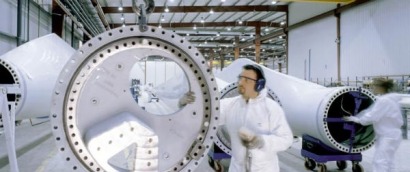
According to sources close to the test centre, the Spanish wind turbine manufacturer has been selected as the technologist to install two G10x machines, each with 4.5 MW of capacity, at the new facility in the Port of Arinaga de Gran Canaria, which aims to speed up development of offshore wind in Spain. The Canary Islands Technology Institute (ITC) has neither denied nor confirmed the reports but does admit that the consortium behind the centre, Megaturbinas Arinaga, is in negotiations with Gamesa.
Despite refusing to confirm the rumour, Gonzalo Piernavieja, Director of the ITC, took the opportunity to explain some details of the project to Renewable Energy Magazine’s Mike McGovern. "We are situated in an ideal area, southeast of Gran Canaria, where there is more wind than almost anywhere else in the world," explained Piernavieja. "Here we have wind farms operating 4,500 hours, five miles offshore: the wind farm with a world record [of annual hours of operation], shared with one in Costa Rica, with 5,000 hours".
The project is part of the Canary Islands’ long-standing commitment to renewable energy in general and the Canary Islands Energy Plan, which sets a target of covering 30% of the archipelago’s power consumption with clean sources by 2015, says Piernavieja.
Aeronautical obstacles
For now, Megaturbinas Arinaga’s project still has to overcome several planning hurdles, explains Piernavieja. One of the main obstacles is to obtain approval from AENA (Spanish Airports and Air Navigation), after ascertaining that the two wind turbines do not interfere with the Devor systems involved in switching aircrafts from manual control to automatic pilot on take-off.
A firm commitment to offshore wind
Gamesa makes no secret of its intention to fully enter the offshore segment, which will absorb a large portion of its investments in R&D in the coming years.
The company has already established an offshore wind R&D centre in the US town of Hampton Roads, Virginia, which will open shortly. Developed in partnership with Northrop Grumman Corporation, the facility will employ a staff of 40 engineers and techniciansand will focus on developing and installing the first prototype of the new machine G11 five-megawatt wind turbine.
In addition, this year Gamesa plans to open a new offshore wind R&D centre in Scotland, responsible for developing the new G14 machine with 6-7 MW of power, the first prototype of which is planned for mass production in 2015. Alongside this commitment to R&D, Gamesa also plans to invest around €150 million in the UK to establish its global offshore wind base.
Diversification into other renewables
Gamesa has also revealed plans to establish a venture capital fund and invest up to €50 million over the next five years to buy stakes, initially minority holdings, in companies engaged in the development of the most promising technologies of the future, “targeting wave and next generation photovoltaic energies, energy storage, green mobility, energy efficiency and off-grid systems”.
The company says it is “determined to ensure its medium- and long-term growth and leadership in the energy technology market both in the wind business (land-based and offshore) and in the development of new renewable technologies that offer high growth potential in the medium and long term”. To this end, it has launched a technological diversification strategy in new renewable energies which will enable it “to participate actively in alternative sources of growth, capture innovation and complement and capitalise on potential synergies with Gamesa's manufacturing activities”.
Gamesa’s first investments as part of this strategy have been the acquisition of 28.7% of SkyBuilt Power and the 25% of WorldWater & Solar Technologies, which specialise in off-grid solutions. In return, the company explains that it will offer “its market position, skill and experience in technology, manufacturing and finance and its local supply chain to achieve greater market competitiveness and, in consequence, higher financial and strategic returns”.
Gamesa reveals that in the medium and long term, it will consider taking the companies over, either as new business lines or as sources of value via spin-offs on capital markets.
Gamesa is interested in six key technologies around which it will base its research and investment decisions in international markets: wave (converting tidal currents and waves into energy); next generation photovoltaic energy (converting the sun's photonic energy into electricity); energy storage designed to guarantee high-quality supply; green mobility (electric vehicles); energy efficiency (maximising energy use while minimising consumption); and off-grid (small renewable generation units that are not connected to power grids, for use in remote locations).
For additional information:

